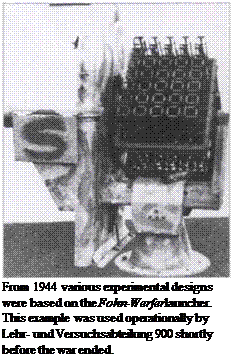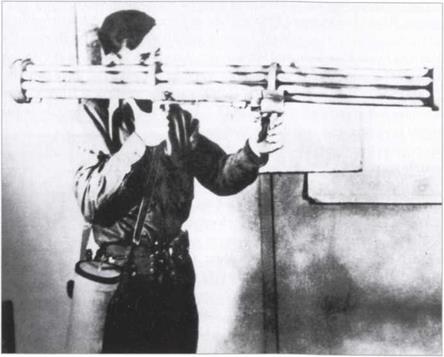Fohn, Taifun and Other Developments
Shortly before the war ended the development of costly flak rockets such as Wasserfall had come to nothing. The last remaining hope was simple projectiles under construction which could be turned out in large numbers in various versions. These included the Fohn and Taifun. The latter was an unguided, arrow – shaped stabilised flak-rocket shell of 10-cm diameter. Easy to produce, it was propelled by either a solid-fuel or liquid-fuel motor and was stabilised by four tail fins. 1.98 metres (variant F) or 2.10 metres (variant P) in length (6 ft 6 in or 6 ft 11 in), the projectile could hit at 10,000 metres (33,000 ft) altitude. Salvoes of up to 48 rounds could be fired at a time from a multiple launcher on an 8.8-cm Flak 36 or 37 mounting. Taifun was an independent development of the Elektro – mechanische Werke (EW).
Development began at the beginning of 1944. On 14 September 1944 80 were ordered from EW and another 420 from Benteler Werke at Bielefeld. In October 1944, in order to speed up the development, the Taifun work-group was established. Problems with materials went hand in hand with a shortage of experienced specialists and technicians. The shortage of expert workers led in December 1944 to a postponement of the desperately needed ballistic testing for a month. The powerplant also caused concerns in the initial phase.
By January 1945 flight testing had shown that the projectile tender to wander about its axis if the start velocity was too slow, and as a remedy longer rails were introduced on the starting launch trailer. Structural changes also stopped Taifun rockets exploding on tests. On 13 January the first examples were fired with live warheads. Although these exploded satisfactorily when the clockwork stopped, the liquid-fuel rockets were widely dispersed. For simplicity of construction solid – fuel rockets seemed preferable, and the first test with a rocket of this kind was not long delayed, the first being fired at Torgelow and – according to visual observations – followed a good flight path. By the end of January, 11 Taifun F had been fired with good results, although in another test 6 of 20 exploded in mid-air without a reason being found. Constant problems hampered progress in the subsequent weeks, and by the end of March 1945 neither had the Taifun P made its test debut at the front nor had series production of the F version begun, even though both F and P were listed on the Fiihrer Emergency Programme.
 Therefore all-last minute efforts to series – produce the Taifun were in vain. By the war’s end only 100 rockets had been completed.
Therefore all-last minute efforts to series – produce the Taifun were in vain. By the war’s end only 100 rockets had been completed.
The only flak rocket ever used against enemy bombers was the primitive Fohn, which existed in numerous variations and had been subjected to some practical tests. A spin-stabilised Fohn projectile was tested experimentally in the armaments factory at Brno in October 1943. The intention was that salvoes of between 18 and 48 rockets would be used to bring down low-flying enemy aircraft. One month later the new Flak Emergency Programme foresaw the production of 1,000 Fohn by the end of April 1945, while construction of a multiple launcher, Fla-R-Werfer 44, for use against low-flying aircraft was also begun; 25 of these were scheduled for delivery by late October 1944.
The first projectiles built in November 1944 were used for evaluation purposes by Rheinmetall at the Unterliiss range. It was found that a five-man crew was sufficient. The first salvo of 5.5-cm rockets was fired at Wischau on 26 November 1944. The later series was of 7.3-cm calibre. In operational testing up to the end of 1944, 15,000 had been fire at enemy aircraft, but only one was shot down. In December 1944, 5,000 were fired in 70 salvoes at enemy machines at ranges between one kilometre and 1,500 metres, two hits being reported.
The principal drawback of the Fohn launcher was its short range of only 1,250 metres. At the beginning of 1945 the first of three experimental batteries from Flugabwehrschule (Flak-school) 2 were brought from Rerik on the Baltic to the Western Front. Flak-Lehr und Versuchsabteilung (Flak Instruction and Testing Unit) 900 commanded by Major Ehm was later composed of three batteries: I./900 railway flak on flat wagons, II./900 partially motorised, III./900 fixed localities and operational testing. On 28 February 1945,59 mobile 7.3-cm flak rocket launchers were available for training and operations, together with 24 permanent units mainly for training.
 At the beginning of February 1945, III./900, consisting of three companies with a total of 120 men under the command of Oberleutnant Karl-Heinz Peters, arrived in the Remagen area on detachment to the local Flakfuhrer for tactical purposes. Over the next few weeks the rocket battery engaged a number of enemy aircraft, particularly single-engined fighter bombers, without success. The unit had 21,000 projectiles and plentiful reserves but only a single 3-tonne lorry. III./900 at Remagen was split into two halves, one stationed on the west bank, the other on the east bank of the Rhine.
At the beginning of February 1945, III./900, consisting of three companies with a total of 120 men under the command of Oberleutnant Karl-Heinz Peters, arrived in the Remagen area on detachment to the local Flakfuhrer for tactical purposes. Over the next few weeks the rocket battery engaged a number of enemy aircraft, particularly single-engined fighter bombers, without success. The unit had 21,000 projectiles and plentiful reserves but only a single 3-tonne lorry. III./900 at Remagen was split into two halves, one stationed on the west bank, the other on the east bank of the Rhine.
On 7 March, Allied units advanced into the area in strength to capture the bridge over the Rhine. That morning the battery crews on the west bank crossed to the east after having destroyed their rockets and the sight mechanism on the launcher. The batteries were abandoned because there were no towing vehicles available. Following this incident, a flying court-martial was set up by Generalfeldmarschall Kesselring on 10 March. Oberleutnant Peters was sentenced to death and executed by firing squad in a wood near Rimbach on the 13th. Generalmajor Adolf Erhard, Commander 7. Flakdivision, committed suicide in protest against the sentence on the 14th. Whether there were any engagements involving the use of the launcher on the east bank is unknown.
Another interesting weapon was the HASAG Fliegerfaust in which the Riistungsstab had set great hopes in the spring of 1945. The Fliegerfaust was a simply produced but powerful weapon which enabled the individual infantryman on the battlefield to defend himself against low-flying aircraft. It was made up of nine 2-cm barrels and could be used against aerial targets at a range of 500
|
Fliegerfaust A and В were designed for the protection of ground troops on the battlefield. Trials were begun under operational conditions but not completed. |
metres. The first version appeared on 15 December 1944. Almost ready by the end of the year, 10,000 weapons and 4 million rounds were expected in January. A problem preventing the early introduction of the Fliegerfaust was vibration after firing. On 21 January 1945 the first hundred of the pre-series were ready. Problems with ammunition included difficulties in manufacturing machinery to produce porcelain nozzles for the rounds. On 4 February the weapon was designated ‘FF I and IT. According to Oberleutnant Jorg Muller when in US Third Army captivity, in mid-March there was a short test period at Saar – briicken. The large number of FF required could not be met.
The claim attributed to Hermann Goring ‘The technology must obey me!’ showed how litde the Luftwaffe leadership understood the development of new weapons. They designed numerous, basically futuristic, flak rockets and other very good ideas, but the general situation ensured that these were only available at best as examples.











